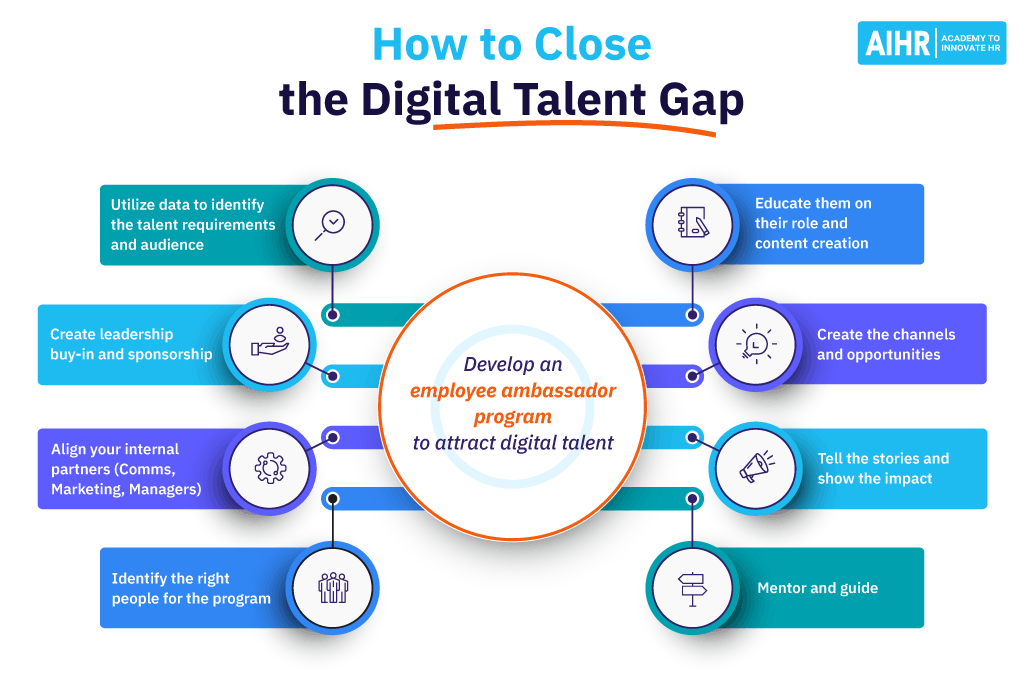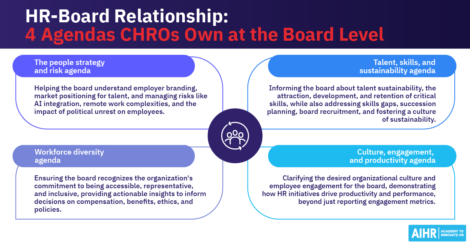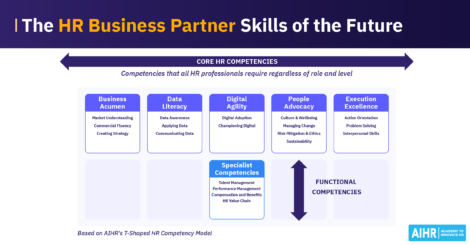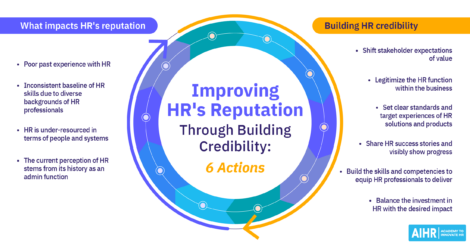How to Close the Digital Talent Gap with Employee Ambassador Programs: 8 Steps for Success

With the rise of remote work and digital business models, the demand for skilled digital and IT talent is increasing and will continue to do so over the coming years. However, organizations struggle to attract and retain employees with digital skills, which results in a digital talent gap. How can you utilize employee ambassador programs to become an attractive employer for this talent segment?
We talked to Annette Breetzke, Human Capital Executive for Group IT at Momentum Metropolitan, a multi-national insurance organization, to discuss the state of digital talent and how to build employee ambassador programs to attract and recruit employees with digital skills. Check out the full interview below:
Let’s dive in!
Contents
The state of digital talent
What does digital talent want?
How to attract digital talent with an employee ambassador program
The state of digital talent and the digital talent gap
The rise of remote work and digital business models has led to an increased demand for skilled digital and IT talent. This year alone has seen a 40% increase in digital and IT job postings compared to last year. A recent study by Willis Towers Watson highlighted that 93% of employers worldwide struggle to attract digital talent.
The digital talent gap is becoming more pronounced. WEF estimates that 133 million new IT jobs will be created in the near future to meet the demands of automation, new technologies, and digital business transformation.
Digital talent scarcity is nothing new. Ever since the “.com” era, attracting and retaining digital and IT talent have been top of mind for HR. Movements such as the Great Resignation also shape this trend and lead to organizations paying exorbitant amounts of money to get digital talent to join, only to lose them again as a more attractive offer comes along.
A survey by the Everest Group states that there has been a 30% increase in attrition for key roles. This trend is set to continue. Traditional talent attraction and retention strategies are failing, and digital talent pipelines are in short supply. In other words, companies need to be creative when it comes to recruiting digital talent.
What does digital talent want?
In a highly employee-driven talent market, critical considerations such as employer brand, employee experience, and value proposition have become differentiators when talent evaluates your attractiveness.
Even before the pandemic, what talent wanted and expected from employers changed. Concepts such as stability, security, and predictable work have been replaced with meaningful work, growth opportunities, and work that has a societal impact. Digital talent, especially the younger generation, wants to do work that matters. They’re looking for employers that provide them with those opportunities.
Coupled with a need to work with exciting new technologies and challenging work, the real question becomes what companies offer in terms of the holistic employee experience. Traditional levers are still there, such as competitive remuneration and learning opportunities.
However, there has been a significant rise in factors such as career growth, culture, flexibility, and the ability to work on multiple initiatives. Popular media has not done traditional corporates any favors. They often portray these workplaces as bureaucratic, politically charged, and especially for digital talent, not as a place to do exciting, impactful work.
With remote work and flexibility becoming more commonplace in digital talent value propositions, we also see the increased interest for digital talent in terms of who they will be working with.
The digital talent community is very connected. We are observing that working alongside subject matter experts, thought leaders, and respected digital changemakers is becoming a key consideration when digital talent chooses employers.
This has significant implications for talent branding as some organizations have limited digital talent visibility outside the organization. Visibility of your digital talent, expertise, and leadership cadre is becoming an important consideration to be perceived as an attractive organization.
How to attract digital talent with an employee ambassador program
Employee ambassador programs are nothing new. Yet, the rise of social media and digital communities has increased their relevance and reach over the past two years. Companies with robust programs have experienced:
- increased visibility of job postings,
- 8X more engagement on social media,
- and employee-generated content being shared 25 times more frequently than traditional marketing materials.
Your employees are already on social media. However, leveraging their reach and networks for your talent efforts is challenging without a guided and considered strategy. So how can you, as HR, implement a robust and effective ambassador program to bridge your digital talent gap?
Step 1: Utilize data to identify the talent requirements and audience
First, you need to understand the talent requirements within this talent pool. Using a simple talent segmentation model, you can think about your talent pools regarding scarcity (how difficult this talent is to find) and criticality (how vital this talent is for our business). This step enables you to understand the specific specialist areas of focus for the employee ambassador program.
Employee ambassador programs need to be targeted. Ensure that your program is tailored to a specific target audience and is not too generic.
At Momentum Metropolitan (MM), they started by gaining an in-depth understanding of the IT role family, the current digital talent supply, and the demands for growing skills in that talent segment. Working with external partners such as LinkedIn, they also gathered data to better understand the characteristics of that talent segment in the market. That helped them focus their program on the right talent pools.
Step 2: Create leadership buy-in and sponsorship
You need to bring leaders onboard and help them understand the purpose and value of the program. Be clear and transparent about what the program is hoping to achieve and what challenges it will face. More importantly, communicate what you need from the leadership team to set this process up for success.
Even though HR facilitates the program, it is ultimately owned by the business. Be clear that leaders who have employees as ambassadors in their teams have an essential role to play in terms of support, enablement, and being open to allowing them to engage in these activities. This should be a part of, and not on top of, their job.
The idea of an employee ambassador program was initially met with a lot of resistance at MM. Annette Breetzke mentions they came up with a way to overcome this resistance. They started small, working with the few leaders who saw value in the program until they could demonstrate the impact on a larger scale.
Step 3: Align your internal partners (Comms, Marketing, Managers)
You also need to focus on bringing your internal partners onboard. To succeed, employee ambassador programs must be co-owned by Marketing, Internal Communications, and HR. During this stage, you need to agree on roles and responsibilities and a way of working together. Annette framed the contribution of partners as follows:
- HR will identify, educate, and coach ambassadors
- Marketing will define how we measure impact, promote content to gain traction, and
- Internal communications have to build internal credibility and awareness of the program
A good practice is also to have a targeted approach to get your employees behind the ambassadors. Especially regarding social media engagement, it is valuable to have an additional cohort of employees supporting and engaging with brand ambassador content. Before launching the program externally, MM launched it internally into the IT community and introduced the ambassadors to the organization.
Step 4: Identify the right people for the program
This is the most essential and crucial step. A common mistake organizations make is letting managers nominate employees who do not have any interest in this program. There has to be some individual career-focused benefit for the individual to participate – whether that is about building their personal brand, giving them exposure to additional opportunities, or sharing their knowledge with the next generation of talent.
Depending on the target audience, you also have to ensure that employees that already have a voice and presence in those communities form part of the program. This will give your employer brand more credibility, which, in turn, helps you start closing the digital talent gap.
Step 5: Educate them on their role and content creation
This step entails the education of selected ambassadors. The list below provides an overview of what you should cover during this step. Of course, it is crucial to adapt it to the context and objective of your program:
- The purpose and aim of this program
- Why you chose them as an ambassador
- How do people consume content, and what does acceptable content look like?
- How to engage with followers
- The importance of consistency in engagement
- Basic writing and speaking guidelines and skills
- Metrics and feedback that they can track to see the impact
- What to do when things go wrong
- The support that is available to them as part of this program
This will be new territory for most employees. You should spend time during this step to help them become confident and be clear on what you expect from them.
Annette mentioned that as HR, you need to become comfortable with the notion that employees will not get it right all of the time. There will be moments when employees with the best intentions share undesirable content, forget to check their spelling or mess up a public presentation at a high-profile conference. Accept these mistakes with grace, learn from them and then move on.
Step 6: Create the channels and opportunities
For your employee ambassador program to succeed in closing the digital talent gap, you need to help employees understand how to connect with others and optimize the use of their content aligned to the selected channels. When using channels such as LinkedIn, this could entail helping employees create or update their profiles.
At MM, Annette and the team organized a professional photoshoot. They also arranged a “Rock your Profile” workshop with ambassadors to give their profiles a much-needed makeover.
It is beneficial to have some initial content planned for each participant. At a minimum, help them identify opportunities to gather content.
Consistency and frequency are essential. You need to agree on a schedule of activity for ambassadors to share and engage with their followers.
Step 7: Tell the stories and show the impact
As your ambassadors start to engage with content and the community, it is essential to share the success stories. To gain momentum, identify some of the small wins that the program is delivering while you wait for the more significant impact metrics to become available.
Bear in mind that this is a longer-term initiative. Some success metrics, e.g., growth in the quality of the talent pipeline, will only be measurable after a couple of months.
There should, however, be visibility of whether the program is creating impact. Be sure to collect both quantitative and qualitative data to showcase this.
Testimonials are powerful ways to validate the program by asking new joiners for feedback, such as “How did you hear about us?” or “What words come to mind when you think about us as a brand?”
At MM, more and more of the digital talent appointments resulted from online social engagement with ambassadors that piqued the interest of potential talent. Making these success stories visible helped demonstrate the impact of the program and convert some of the leaders who remained skeptical of its success.
Step 8: Mentor and guide
You need to ensure that ambassadors receive regular mentorship and guidance. Be sure to check in with them frequently and see how and where they need additional support or advice.
Ambassadors often need encouragement to continue their efforts while sharing some of their uncertainties or concerns. Putting yourself out into the public domain can be daunting, and these sessions help them debrief and refocus.
A final word
In the changing world of work, attracting and retaining digital talent is challenging. Traditional approaches to filling the digital talent gap are failing, and HR leaders are seeking new ideas and approaches to differentiate their talent brands in a highly competitive, employee-driven market.
Digital talent ambassador programs are a viable and accessible strategy for organizations to rethink attraction and promote who they are as an employer through real, authentic employee-generated content. If organizations do not respond, they risk being forgotten in a short-on talent supply market.
Weekly update
Stay up-to-date with the latest news, trends, and resources in HR
Learn more
Related articles
Are you ready for the future of HR?
Learn modern and relevant HR skills, online












